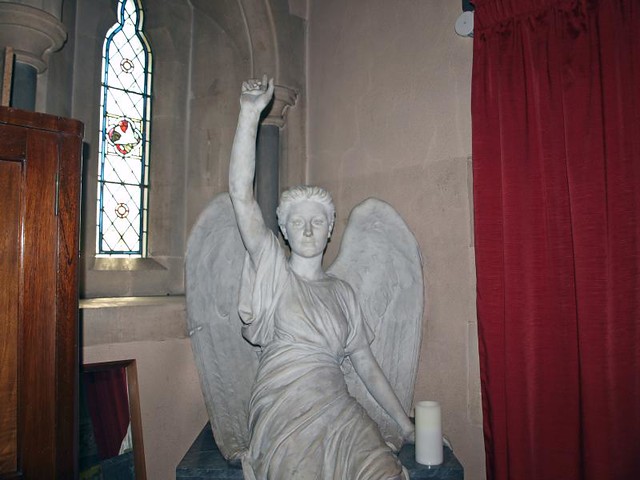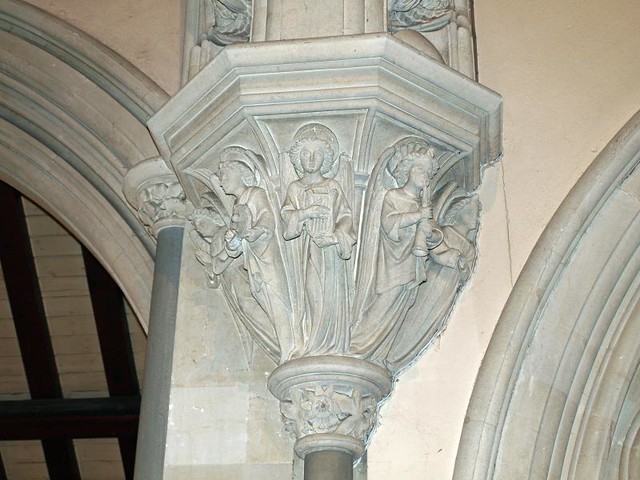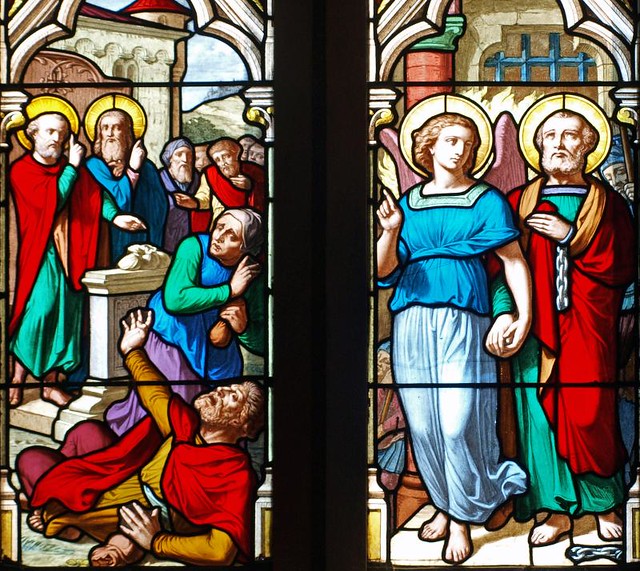ST PAUL, 1865, by H. Woodyer. The exterior is unpromising, though ambitious for so small a parish. Flint. Nave, chancel, S chapel, and W tower with short spire. The detail rather coarse. Inside a most ornamental chancel arch, the very beau ideal for the pious and sentimental Victorian: musician angels on each of the two capitals and angels arranged radially on the arch. Otherwise also handsomely decorated. In the S chapel MONUMENTS of William Jones Loyd of Langleybury House d. 1885 and of Caroline.Gertrude Walker Loyd d. 1893, the former with marble putti holding a portrait medallion, the latter with a seated, nearly life-size angel with raised arm in the cemeterial style.
Langleybury. It is by the canal, between King’s Langley and Watford, with its church in the midst of the busy road. The church, which has a graceful shingled spire, is entered by a fine oak lychgate, the churchyard is fringed with trimmed limes which make arches over two other gates; they were planted when the church was built of flint and stone in 1864. by William Jones Loyd, of the big house in the park. A tribute to him is the great cross of Silician marble near the porch, richly carved with the Crucifixion and four panels with groups of the Disciples, the work of a Florentine sculptor. In the south chapel, where he and his family sleep, the founder has a monument with cherubs. Gertrude Loyd’s monument of 1898 is an angel with uplifted hand, sitting on a tomb. A tile mosaic showing the Good Shepherd is to Sir John Runtz, and there are two Flanders crosses. Rich stonework is a feature of the church inside; angels are between the arches of the arcade; and the chancel arch resting on angel corbels is adorned with 24 canopies sheltering angels with shields and scrolls and musical instruments.
One of the windows is in memory of a 19th-century Lord Mayor of London, William Taylor Copeland, who was for many years head of the Spode pottery firm at Stoke-on-Trent. He sat in Parliament and took great interest in civic affairs, and his wise direction of the pottery works, in cooperation with well-known sculptors, won for it worldwide renown. He died at Russell Farm, Watford, and he is known to collectors everywhere as the maker of beautiful porcelain.
Lovely wooded hills rise gently behind the church, and a charming walk leads by West Wood to Buck’s Hill a mile and a half away. At Hunton Bridge, across the canal, is the house called King’s Lodge, a low building dating from the 17th century, lengthened in the 19th, and refaced with brick. On its wall outside are old panels with leaves and flowers and 1642, when it is thought to have been built. It is said to have been a hunting lodge of the Stuarts. One of its rooms has a finely decorated plaster ceiling, and a big fireplace with the royal arms and 1642. For a time it was divided into two dwellings.
One of the windows is in memory of a 19th-century Lord Mayor of London, William Taylor Copeland, who was for many years head of the Spode pottery firm at Stoke-on-Trent. He sat in Parliament and took great interest in civic affairs, and his wise direction of the pottery works, in cooperation with well-known sculptors, won for it worldwide renown. He died at Russell Farm, Watford, and he is known to collectors everywhere as the maker of beautiful porcelain.
Lovely wooded hills rise gently behind the church, and a charming walk leads by West Wood to Buck’s Hill a mile and a half away. At Hunton Bridge, across the canal, is the house called King’s Lodge, a low building dating from the 17th century, lengthened in the 19th, and refaced with brick. On its wall outside are old panels with leaves and flowers and 1642, when it is thought to have been built. It is said to have been a hunting lodge of the Stuarts. One of its rooms has a finely decorated plaster ceiling, and a big fireplace with the royal arms and 1642. For a time it was divided into two dwellings.



No comments:
Post a Comment